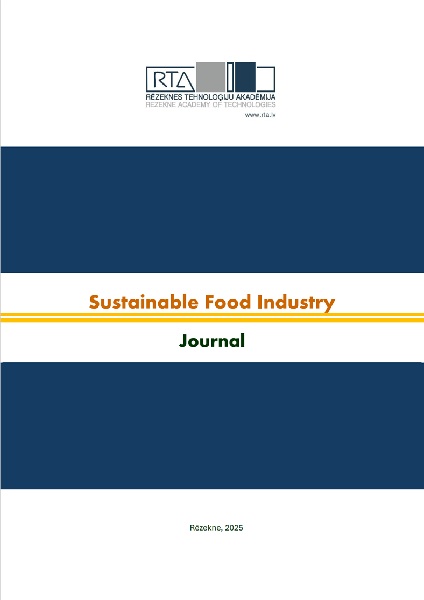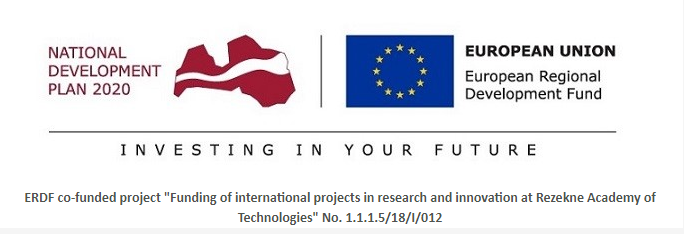THE EFFICIENCY OF USING INNOVATIVE SOIL LIMING AND FERTILIZER MEANS IN WINTER WHEAT SOWINGS
DOI:
https://doi.org/10.17770/sfi2025.1.1.8375Keywords:
Digestate, wood ash, mixtures, winter wheatAbstract
Field trials were conducted at the Study and Research Farm “Peterlauki” of the Latvia University of Life Sciences and Technologies from 2020 to 2023. Soil characteristics: sod - stagnogley soil Luvisols (according to FAO classification); granulometric composition – heavy dusty sand clay. Winter wheat sowings were established using different variants of a fertilizer mix with cattle (from JSC “Ziedi JP”) manure digestate (D) and wood ash (P) (from LLC “Gren Jelgava”) in different ratios. The norms of the innovative mixed fertilizer for cattle manure digestate and wood ash were 5, 10, and 20 t per ha. Unfertilized winter wheat plots were used as control. Variants in the two-factor trial were randomized in triplicate. In the experiment, the influence of the researched factors on winter wheat grain yield, the content of protein, starch and gluten in grains, Zeleny index, grain volumetric weight (kg per hL), and the mass of 1000 grains were determined. The aim of the study was to determine the impact of biogas fermentation by-product (digestate) and cogeneration plant and boiler house residues (wood ash) on the yield and quality of winter wheat. Depending on the study variant, the winter wheat yield varied on average three years from 6.29 to 7.39 t per ha. It was established that the average winter wheat grain yield in the control variant was 5.05 t per ha, which is significantly (p<0.05) lower than in the variants using fertilizers of digestate and wood ash mixtures. Using digestate and wood ash mixtures, sufficiently high and high-quality winter wheat yields can be obtained without the use of mineral fertilizers. The mixtures of digestate and wood ash are an innovative fertilizer way for improving the soil fertility, which is also suitable for winter wheat.
References
Abubaker J., Elnesairy N., Ahmad S. (2017). Effects of non-digested and anaerobically digested farmyard manures on wheat crop cultivated in desert soil. Journal of Arid Land, 3, p. 1–10.
Abubaker J., Risberg K., Jönsson E., Dahlin A.S., Cederlund H., Pell M. (2015). Short-term effects of biogas digestates and pig slurry application on soil microbial activity. Applied and Environmental Soil Science. Available: https://www.hindawi.com/journals/aess/2015/658542/ [viewed 18.02.2024].
Ai Y, Jane, J. (2018). Understanding starch structure and functionality. In Starch in Food, p. 151-178. Woodhead Publishing. https://dx.doi.org/10.1016/B978-0-08-100868-3.00003-2
Alburquerque J. A., Fuente C., Ferrer-Costak A., Carrasco L., Cegarra J., Abad M. (2012). Assessment of the fertiliser potential of digestates from farm and agroindustrial residues. Biomass Bioenergy, 40, p. 181–189.
Augusto, L., Bakker M. R., Meredieu C. (2008). Wood ash applications to temperate forest ecosystems—potential benefits and drawbacks. Plant and Soil. Vol. 306, No. 1/2, Part I: Special Issue, p. 181-198.
Biesiekierski J. R. (2017) What Is Gluten? J. Gastroenterol. Hepatol. 32 (Suppl. S1), p. 78–81. doi: 10.1111/jgh.13703.
Bhatt A.H., Tao L. (2020). Economic perspectives of biogas production via anaerobic digestion.
Demeyer A., Nkana J.C.V, Verloo M.G. (2001). Characteristics of wood ash and influence on soil properties and nutrient uptake: an overview. Bioresour Technol, Vol.77, p. 287–295
Comparetti A., Febo P., Greco C., Orlando S. (2013) Current state and future of biogas and digestate production. Bulgarian Journal of Agricultural Science, 19, p. 1–14.
Corden C., Bougas K., Cunningham E., Tyrer D., Kreißig J., Crookes M. (2019) Digestate and Compost as Fertilisers: Risk Assessment and Risk Management Options. Wood Environment & Infrastructure Solutions UK Limited; Aberdeen, UK. Available: https://ec.europa.eu/environment/chemicals/reach/pdf/40039 Digestate and Compost RMOA—Final report i2_20190208.pdf. [viewed 20.02.2024].
Dubrovskis V., Adamovics A. (2012). Bioenerģijas horizonti. Jelgava. p. 352.
Gutser R., Ebertseder T., Weber A., Schraml M., Schmidhalter U. (2005). Short-term and residual availability of nitrogen after long-term application of organic fertilizers on arable land. Journal of Plant Nutrition and Soil Science, 168, p. 439–446.
Ingerslev M., Skov S. Sevel L and. Pedersen L . B (2011). Element budgets of forest biomass combustion and ash fertilization – A Danish case-study. Biomass and Bioenergy. Vol. 35(7), p. 2697-2704.
Hjorth M., Christensen K. V., Christensen M. L., Sommer S. G. (2010). Solid-liquid separation of animal slurry in theory and practice. Agronomy for Sustainable Development, 30, p.153–180.
Hejcman M., Ondracek J., Smrz Z. (2011) Ancient waste pits with wood ash irreversibly increase crop production in Central Europe. Plant and Soil. Vol. 339 (1), p. 341 – 350.
Jakab P., Festo D., Zoltan G., Komarek L. (2019) The effect of different fertilizer tratments on the yield and quality of winter wheat. Review on Agriculture and Rural Development. Vol. 6 (1 – 2), p. 182 – 187.
Kozlovský O.,. Balík J ,. Černý J , Kulhánek M., Kos M., Prášilová M. 2009 Influence of nitrogen fertilizer injection (CULTAN) on yield, yield components formation and quality of winter wheat grain. Plant, Soil and Environment. 55 (12), p. 536-543
Koszel M., Kocira A., Lorencowicz E. (2016). The evaluation of the use of biogas plant digestate as fertilizer in alfalfa and spring wheat cultivation. Fresenius Environmental Bulletin, 25, p. 3258–3264.
Kunkulberga D., Segliņš V. (2010) Maizes ražošanas tehnoloģija (Bread production technology). Rīga : RTU izdevniecība, p. 53—54. (in latvian)
Li X., Yun S., Zhang C., Fang W., Huang X., Du T. (2018). Application of nano-scale transition metal carbides as accelerants in anaerobic digestion. International Journal of Hydrogen Energy, 43, p.1926–1936.
Ooms N., Delcour J.A. (2019) How to Impact Gluten Protein Network Formation during Wheat Flour Dough Making. Curr. Opin. Food Sci. 25:88–97.
Panuccio M.R., Papalia T., Attina E., Giuffre A., Muscolo A. (2018). Use of digestate as an alternative to mineral fertilizer: effects on growth and crop quality. Archives of Agronomy and Soil Science, 65, p. 700–711.
Pitman R. M. (2006). Wood ash use in forestry – a review of the environmental impacts. Forestry, Vol. 79, p. 563 – 586.
Przygocka-Cyna K., Grzebisz W. (2018). Biogas digestate – benefits and risks for soil fertility and crop quality – an evaluation of grain maize response. Open Chemistry, 16 (1), p. 258-271.
Riva C., Orzi V., Carozzi M., Acutis M., Boccasile G., Lonati S., Tambone F, D’Imporzano G., Adani F. (2016). Short-term experiments in using digestate products as substitutes for mineral (N) fertilizer: agronomic performance, odours, and ammonia emission impacts. Science of The Total Environment, 547, p. 206–214.
Różyło K., Gawlik-Dziki U., Swieca M., Różyło R., Pałys E. (2015). Winter wheat fertilized with biogas residue and mining waste - yielding and the quality of grain. Journal of the Science of Food and Agriculture, 96 (10), p. 3454–3461.
Sänger A., Geisseler D., Ludwig B. (2014). C and N dynamics of a range of biogas slurries as a function of application rate and soil texture: a laboratory experiment. Archives of Agronomy and Soil Science, 60, p.1779–1794. Available: https:10.1080/03650340.2014.907491 [viewed 06.09.2023].
Schröder J., Uenk D., Hilhorst G.J. (2007). Long-term nitrogen fertilizer replacement value of cattle manures applied to cut grassland. Plant Soil, 299, p. 83–99.
Shevkani, K., Singh, N., Bajaj, R., Kaur, A. (2017). Wheat starch production, structure, functionality and applications—a review. International Journal of Food Science & Technology, 52(1), p. 38-58.
Sørensen P. (2004). Immobilisation, remineralisation and residual effects in subsequent crops of dairy cattle slurry nitrogen compared to mineral fertiliser nitrogen. Plant Soil, 267, p. 285–296.
Udall D., Rayns F., Charlesworth S. (2017). The Potential of Biochar and Anaerobic Digestate use in a Temperate Conventional Wheat Production System. International Journal of Research in Agriculture and Forestry, 4(10), p. 44-49.
Zariņš Z., Neimane L., Bodnieks E. (2015) Uztura mācība (6. pārstrādātais un papildinātais izd.) (Nutrition education (6th revised and supplemented ed.)). Rīga : LU Akadēmiskais apgāds, p.113. (in latvian)
Downloads
Published
Issue
Section
License
Copyright (c) 2025 Aleksandrs Adamovičs, Liena Poiša

This work is licensed under a Creative Commons Attribution 4.0 International License.



